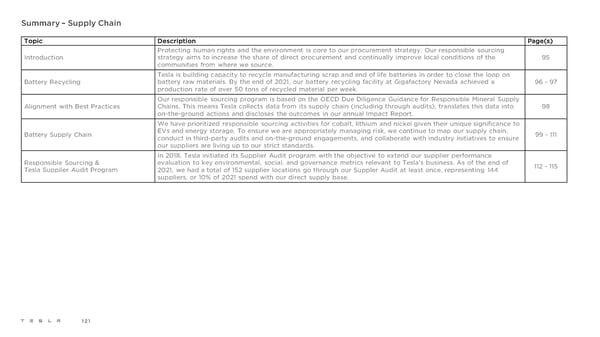Summary –Supply Chain Topic Description Page(s) Protecting human rights and the environment is core to our procurement strategy. Our responsible sourcing Introduction strategy aims to increase the share of direct procurement and continually improve local conditions of the 95 communities from where we source. Tesla is building capacity to recycle manufacturing scrap and end of life batteries in order to close the loop on Battery Recycling battery raw materials. By the end of 2021, our battery recycling facility at Gigafactory Nevada achieved a 96 - 97 production rate of over 50 tons of recycled material per week. Our responsible sourcing program is based on the OECD Due Diligence Guidance for Responsible Mineral Supply Alignment with Best Practices Chains. This means Tesla collects data from its supply chain (including through audits), translates this data into 98 on-the-ground actions and discloses the outcomes in our annual Impact Report. We have prioritized responsible sourcing activities for cobalt, lithium and nickel given their unique significance to Battery Supply Chain EVs and energy storage. To ensure we are appropriately managing risk, we continue to map our supply chain, 99 - 111 conduct in third-party audits and on-the-ground engagements, and collaborate with industry initiatives to ensure our suppliers are living up to our strict standards. In 2018, Tesla initiated its Supplier Audit program with the objective to extend our supplier performance Responsible Sourcing & evaluation to key environmental, social, and governance metrics relevant to Tesla’s business. As of the end of 112 - 115 Tesla Supplier Audit Program 2021, we had a total of 152 supplier locations go through our Suppler Audit at least once, representing 144 suppliers, or 10% of 2021 spend with our direct supply base. 121
 Tesla 2021 Impact Report Page 120 Page 122
Tesla 2021 Impact Report Page 120 Page 122